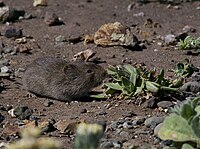
Photo from wikipedia
Intensive management may be necessary to protect some highly vulnerable endangered species, particularly those dependent on water availability regimes that might be disrupted by ongoing climate change. The Amargosa vole… Click to show full abstract
Intensive management may be necessary to protect some highly vulnerable endangered species, particularly those dependent on water availability regimes that might be disrupted by ongoing climate change. The Amargosa vole (Microtus californicus scirpensis) is an increasingly imperiled rodent constrained to rare wetland habitat in the Mojave Desert. In 2014 and 2016, we trapped and radio-collared 30 voles, 24 were translocated and six remained at donor and recipient marshes as resident control voles. Soft-release was performed followed by remote camera and radio-telemetry monitoring. Although comparative metrics were not statistically significant, the mean maximum known distance moved (MDM) was longer for translocated (82.3 ± 14.6 m) vs. resident-control voles (74.9 ± 17.5 m) and for female (98.4 ± 19.9 m) vs. male (57.8 ± 9.1 m) voles. The mean area occupied (AO) tended to be greater in female (0.15 ± 0.04 ha) vs. male (0.12 ± 0.03 ha) voles, and control voles (0.15 ± 0.05 ha) compared with translocated voles (0.13 ± 0.03 ha). The mean minimum known time alive (MTA) was 38.2 ± 19.4 days for resident-control voles and 47.0 ± 10.6 days for translocated voles. Female survival (55.7 ± 14.3 days) exceeded that of males (31.5 ± 9.4 days) regardless of study group. Activity in bulrush/rushes mix and bulrush vegetation types was strongly and significantly overrepresented compared with salt grass and rushes alone, and habitat selection did not differ between resident and translocated voles. Our results provide ecological and methodological insights for future translocations as part of a strategy of promoting long-term survival of an extremely endangered small mammal in a wild desert environment.
Journal Title: PLoS ONE
Year Published: 2019
Link to full text (if available)
Share on Social Media: Sign Up to like & get
recommendations!